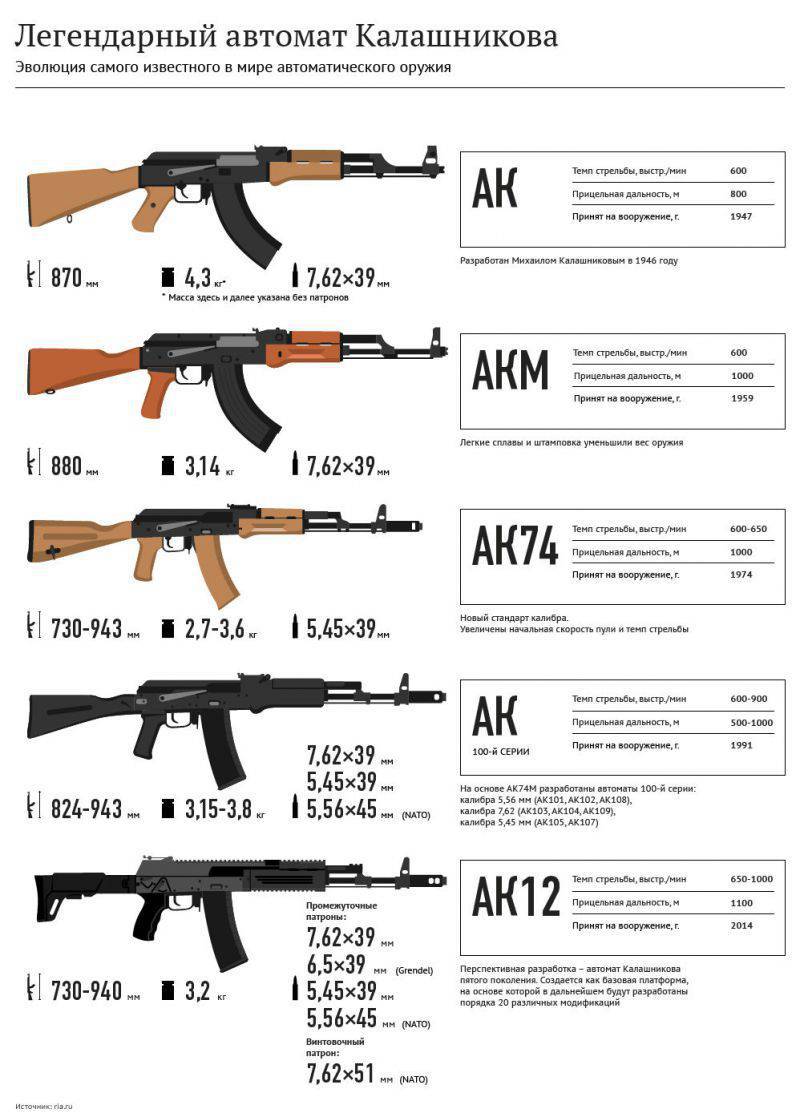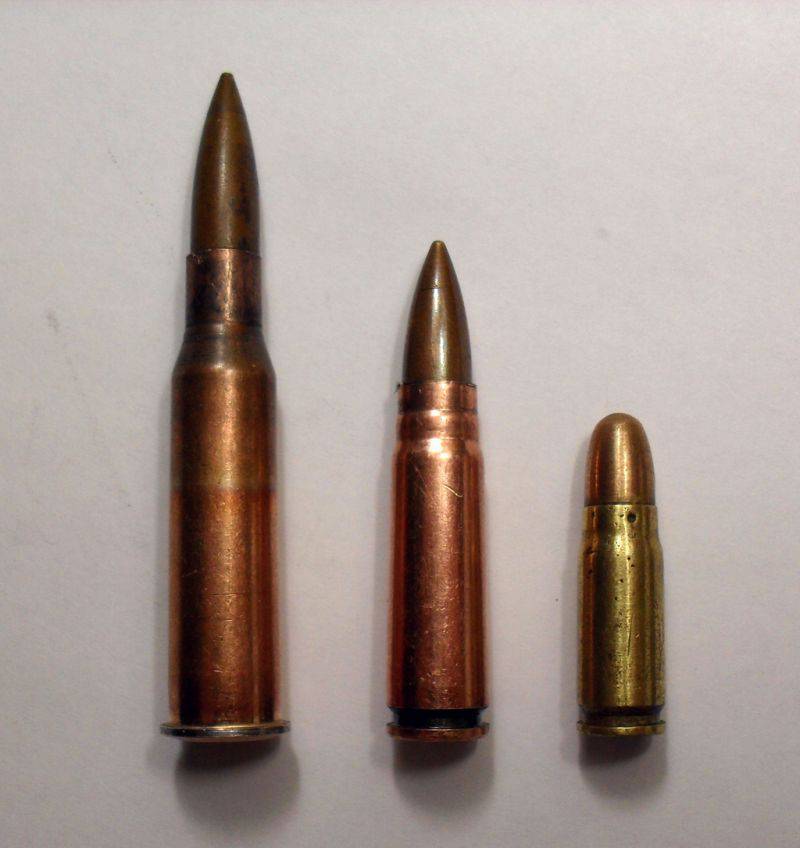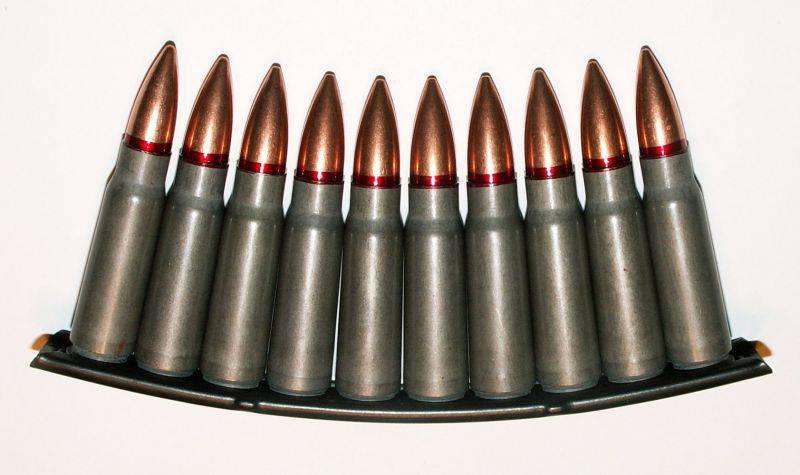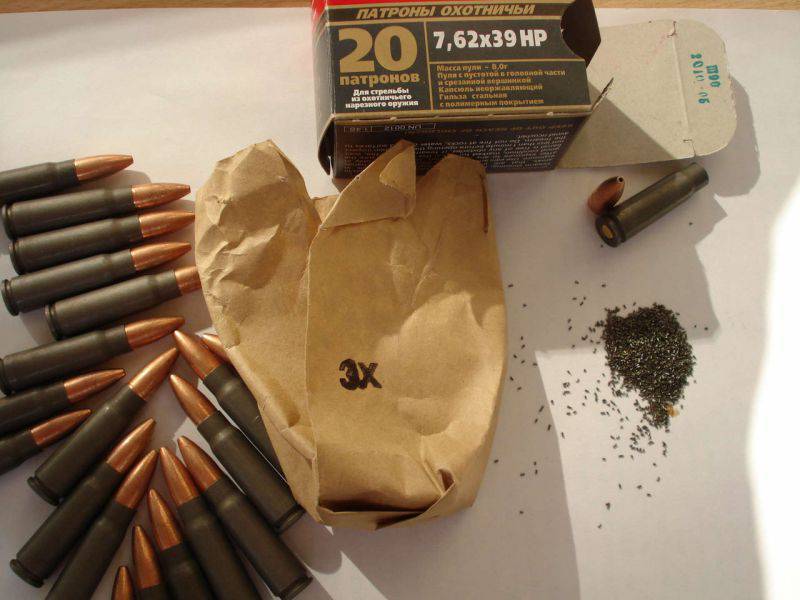Soviet intermediate cartridge 7,62х39
Experts in the field stories making firearms weapons agree that the Soviet cartridge caliber 7,62x39 mm appeared under the influence of the German cartridge 7,92x33 mm or 8 mm "Kurz". In fact, the Soviet model of the patron has become an improved version of the German concept in terms of its shape and efficiency. The 8 mm “Kurz” cartridge was used on the Eastern Front for the first time during World War II, while both German and Soviet troops appreciated its effectiveness quite well. Thus, the German intermediate cartridge and small arms under it gave impetus to Soviet research in this area.
The first work on the development of an intermediate cartridge in the Soviet Union began in the 1939 year, but the question of their creation was raised even earlier. To study this issue in the USSR, a cartridge of the caliber 5,45 mm was created, and even a task was given to create a self-loading rifle for a new cartridge. But due to the outbreak of the Great Patriotic War, Soviet designers temporarily switched to more relevant types of work. As a result, the creation of an intermediate patron was returned only in 1943 year, after members of the Technical Council of the NKV (People’s Commissariat of Armaments) got acquainted with captured samples of German weapons at the front, as well as provided by the USSR for familiarization with the American self-loading carbine M1.
Most of all, the attention of Soviet gunsmiths was attracted by the new German cartridge caliber 7,92х33 mm, specially designed for the MKV 42 [N] carbine, which was tested in the army. This cartridge has a total length of 48 mm (33 mm sleeve length) had a mass of 16,2 gram. With the mass of the 8,2 bullet itself gram and initial speed of about 700 m / s, this cartridge provided accurate shooting at a distance of up to 800 meters. At the meeting, it was decided to create a reduced-power cartridge in order to replace the rifle cartridge in such weapons as the light machine gun and the self-loading (automatic) rifle, as well as new models of small arms specially designed for it. The new intermediate cartridge could be the basis for the development of light individual automatic weapons with a greater range of fire than the submachine guns. Responsible for creating a new cartridge was assigned to OKB-44, which in the future became NII-44, and in 1966 was reorganized into TSNIITOCHMASH. To determine the optimal characteristics of the new ammunition, calculations were made on the choice of mass and bullet speed for 5,6 mm, 6,5 mm and 7,62 mm calibers. These calibers were chosen as the most common in practice.
To the new Soviet cartridge caliber 7,62 mm the following requirements were met: the sleeve must have a modern form - without a flange; weight and dimensions less than the rifle cartridge; cartridge power less by 20% (compared to rifle); the energy of a bullet at a distance of 1000 meters must be no less than 245 J. An intermediate cartridge was created for use in a light machine gun, a self-loading rifle and an automatic carbine machine gun. Small arms, created under the new cartridge, should have been easier, including by reducing the length of the barrel. With the same goal, it was considered possible to use thin rifle barrels for carbines-machine guns (machine guns) without the fear that they would overheat, since the firing basically had to be carried out with single shots and only at the most critical moments of the battle - in bursts.
Taking the point of the report that the flatness of the trajectory is one of the main characteristics for the new cartridge, the OKB-44 specialists from the very beginning of development decided that the new cartridge should be better than the German one. For the German 7,92x33 mm cartridge, the direct shot range (ABS) was 300 meters; for the Soviet cartridge, the DPV was assumed to be equal to 325 meters. Already 3 September 1943, the NKV Technical Council reviewed the first two versions of the cartridge. As a result, a choice was made in favor of one of them, which later received the designation 7,62-mm cartridge model 1943 of the year. After the September meeting, which was attended by all the armory design bureaus and the research and development range of small arms and mortar weapons of the GAU (NIPSMVO), the development of new types of weapons for the advanced automatic cartridge began in the USSR.
Already in December 1943, the first batch of cartridges with a lead core bullet (the cartridge was assigned the index 57-H-231) was tested at the test site. After a slight refinement, starting in March 1944 of the year, the production of an experimental batch of 7,62-mm cartridges of the sample 1943 of the year started. The original version of this cartridge had a sleeve length of 41 mm and a lead core bullet with a short head and no rear cone.
Designed at the same time under the new cartridge samples of small arms - the carbine-automatic (automatic) and self-loading carbine - were primarily intended for firing single shots. It was assumed that the automatic fire will be needed only in melee at a distance of 100-200 meters. Based on this assumption, during the development of the 7,62-mm cartridge of the 1943 model, the focus was on ensuring the required accuracy of fire in single-shot fire, direct shot range and penetration of the bullet. Nobody demanded a high accuracy of fire when using automatic fire from a new cartridge. However, later, when the AK was adopted by the Soviet Army, the main type of firing from a machine gun to increase the density of fire (the number of bullets per linear meter per minute) began to regard fire in lines. Regardless of the distance of the target. In fairness, it can be noted that the probability of hitting a target when firing in bursts grew, but not significantly, while the expenditure of ammunition grew in proportion to the length of the queue.
In the 1944 year, when the hands of the gunsmiths turned out to be the results of the first tests of the new cartridge, work began on improving it in order to improve penetration and accuracy. In the framework of these works, the head (ogival) part of the bullet was lengthened. This allowed to improve the ballistic coefficient with a constant mass of the bullet. Also, the rear cone was inserted in the bullet, which was supposed to serve as a decrease in air resistance during the flight of the bullet. Moreover, as it was then believed, not only at subsonic bullet flight speeds (when firing at a greater range), but also at supersonic flight speeds. In order to preserve the overall length of the cartridge, the cartridge length of the cartridge had to be shortened by 2 mm, and the depth of the bullet in the cartridge was increased. As a result, the sleeve has gained the final length - 38,7 mm (with the designation of the cartridge 7,62х39 the length of the sleeve is indicated rounded). The next stage of work was the replacement of the lead core to the steel.
The bullet, which had a steel core, received the designation - "surrogated." The length of such a bullet has grown from 22,8 mm in the first variant to 26,8 mm. The main argument in favor of using low-carbon steel for the manufacture of the core was not so much the growth of the piercing effect of the ammunition, as the saving of lead (up to 50%), which was then in short supply and high manufacturability of the core forging. The technology of its manufacture was borrowed from the cartridge of the popular TT pistol. It should be noted here that in those years the main criterion for the bullet penetration was the assessment of the possibility of penetration of an army steel helmet at a distance of 800-1000 meters. By the middle of the 1947 of the year, all the deficiencies noted in the test on the 7,62-mm cartridge of the 1943 sample with a conventional bullet were eliminated. GAU decided to release a series of such cartridges and prototypes of weapons for military tests.
In order to increase the tactical capabilities of the small arms under development, as well as on the basis of existing experience in creating 7,62-mm rifle cartridges for various purposes, along with a cartridge equipped with a conventional bullet, a complex of works was carried out to create 1943 patrons of the year with special bullets: armor-piercing (created in 1944 year), tracer and incendiary (created in 1948 year). In the 1949 year, simultaneously with the Kalashnikov assault rifle, the 7,62-mm cartridges of the 1943 model of the year with all the bullet types listed were adopted. Further development of the 1943 model cartridge with an ordinary bullet equipped with a steel core was carried out in the direction of increasing its penetration effect (to ensure the defeat of enemy manpower in individual armor protection), and of the tracer cartridge, in the direction of further increasing the tracer burning time and slowing the start time his burning In the development of these cartridges, the use of new types of gunpowder as a charge, in particular, spherical granulation powder, played a significant role.
The priority in creating this type of powder belonged to the United States. The main advantage of spherical granulation gunpowder was that it provided a high gravimetric density (filling density of the liner) - around 0,85 g / cm3, high manufacturability and increased progressiveness of burning. All this together allowed, with an equal size of the charging chamber, to provide the bullet with greater muzzle energy or, with an equal muzzle energy, to reduce the size of the liner.
Initially, the new cartridge 7,62x39 was made only with a bimetallic sleeve - steel coated with tompac. However, in the 1948 year, due to difficulties in obtaining a bimetal, most of which was previously supplied to the Soviet Union from the USA under a lend-lease, it was decided to produce an automatic cartridge case from brass-plated steel. The process of brass plating, which the USSR borrowed from German industry, was associated with the use of highly toxic substances. Therefore, after the production of bimetal was mastered in the USSR in 1952, automatic cartridges began to be made again from this material. Subsequently, at about the beginning of the 60 of the last century, some Soviet enterprises mastered the production of a steel lacquered sleeve (covered with green lacquer), which provided substantial savings for the tompac. Already in our time, the production of a steel tube with a polymer coating (a special water-polymer solution) was successfully mastered, which significantly reduced the harmfulness of production.
Gamma ammunition caliber 7,62x39 mm included cartridges with a conventional bullet with a steel core PS (index 57-H-231), and with special-purpose bullets. Such ammunition included: armor-piercing incendiary (BZ, index 57-BZ-231), incendiary (G, index 57-З-231), tracer (T-45, index 57-Т-231 П), armor-piercing (BP, 7 index Н23), as well as 7,62-mm cartridge of sample 1943 of the year with a reduced speed of a bullet (CSS, index 57-Н-231 У). For example, a steel core bullet could pierce a steel soldier’s helmet (helmet) at a distance of 900 meters, and an armor-piercing incendiary bullet at a distance of up to 1100 meters. An armor sheet with a thickness of 7 mm, an armor-piercing incendiary bullet confidently pierced at a distance of up to 200 meters. The use of tracer bullets in firing at moving targets provided the best observation of the shooting results and simplified the aiming of the weapon at the target, as well as the targeting process. Shooting at manpower of the enemy, located in cars, armored personnel carriers and motorcycles, as a rule, was conducted by cartridges with armor-piercing incendiary bullets and bullets with a steel core (in the ratio 1: 1). In addition, the ammunition caliber 7,62-mm sample 1943, and included auxiliary cartridges - idle (57-X-231) and training (index 57-H-231UC). The difference between these cartridges is that the training is used to train soldiers in loading weapons, equipping stores and firing shots, such cartridges do not contain a powder charge. At the same time, blank cartridges are designed to simulate the sound of a shot while training soldiers, as well as for weapons salute.
Patron in the market of civilian weapons
Cartridge 7,62x39 mm is loaded into a relatively short one - 39 mm long - flangeless, conical sleeve. While the “elder brother” of this cartridge - the Russian standard rifle cartridge 7,62x54R is fitted with a flange sleeve, which means it is not very well suited for use in automatic weapons - cartridges of caliber 7,62x39 mm are specially optimized for self-loading and automatic firearms. The original 7,62x39 mm cartridge uses a pointed shell bullet of 8 grams. The initial speed of its flight is of the order of 720 m / s at an initial energy level of about 1960 j.
Developed back in 1943, the cartridge was originally conceived for use only for military purposes. Under him in the USSR immediately began the development of a whole family of various firearms - self-loading and shop carbines, machine guns and light machine guns. The 7,62x39 mm cartridge was an intermediate cartridge for lightweight assault rifles that would be easier to handle and could serve soldiers in the ever-changing world of military tactics. The ballistic characteristics of this ammunition were developed based on the destruction of only human targets, without any focus on hunting.
Massive sales of the 7,62x39 mm cartridge on the territory of the former Warsaw Pact countries, as well as in countries formerly belonging to the Soviet Union, significantly affected their availability on the international market for civilian weapons - both for hunting and for sporting purposes. A huge amount of these munitions appeared on the market at the end of the Cold War. The world market is full of proposals chambered for 7,62x39 mm, ranging from classic military designs, for example, AK and SKS, including their civilian versions such as the Ruger Mini-30, and more modern US sports rifles. In some of them, the classic American design AR-15 is combined with the typically Russian caliber 7,62x39 mm.
Some rifles chambered for the 7,62x39 mm caliber, which have a rotatable longitudinal slide and are designed for target shooting and hunting, are also available on the market. Mostly, such models are made in Eastern Europe, for example, the popular Czech hunting rifles of the CZ series. Although some variants of such rifles are also produced by Western companies, for example, the Italian manufacturer Sabatti, which has thus diversified its product line.
And although the 7,62x39 mm cartridge is definitely not the best option in terms of firing accuracy, its characteristics are more than enough for shooting at short distances, especially when it comes to shooting at distances up to 100 meters. In this case, it is undesirable to use weapons of this caliber for firing long distances at a sufficiently serious game, since this caliber does not have enough energy for reliable slaughter action. The caliber 7,62x39 mm can be considered a viable option when hunting for medium-sized game, for example, roe deer, when the distance to the target is no more than 150 meters. Of course, this is not a cartridge for hunting big game, because its slaughter effect may not be enough to guarantee the effectiveness of the hunter's first shot.
Despite these features, 7,62x39 mm cartridges are still popular in Europe and are used with many self-loading rifles, which are used for battled boar hunting. And in the US, this cartridge has become very popular when hunting for various pests, as well as to control the number of foxes, coyotes and other small game. The advantage is that the recoil when firing ammunition caliber 7,62 x39 mm is minimal. This makes the cartridge very popular and enjoyable for use in training and sport shooting, as well as in entertaining shooting popular in some Western countries. The use of such ammunition does not cause fatigue to the shooter, and their self-charging is quite simple.
Information sources:
http://weapon.at.ua/board/11-1-0-31
http://www.dogswar.ru/boepripasy/41-patrony/7581-promejytochnyi-patro.html
https://www.all4shooters.com/ru/glavnaya/boyepripasy/2015-statyi/Boyepripasy-7-62x39mm-vintovochnyy-kalibr-dlya-okhoty-i-sporta
Materials from free sources






Information